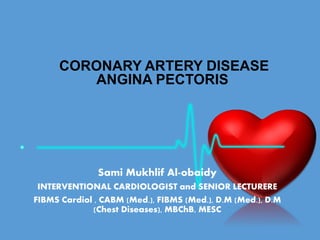This document discusses angina pectoris, its causes, symptoms, diagnosis and management. It provides details on:
- Angina is caused by transient myocardial ischemia due to an imbalance of oxygen supply and demand in the heart. The most common cause is atherosclerosis.
- Risk factors, symptoms, and physical exam findings for angina are described. Management involves identifying and treating risk factors, introducing anti-anginal drugs, and considering revascularization if drugs do not control symptoms.
- Five main classes of anti-anginal drugs are discussed - nitrates, beta-blockers, calcium channel blockers, potassium channel activators, and ivabradine. Their mechanisms of action and usage guidelines are














